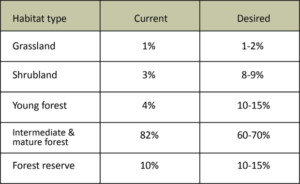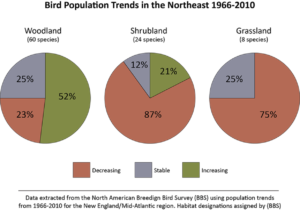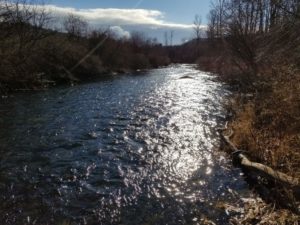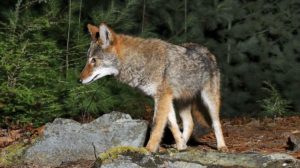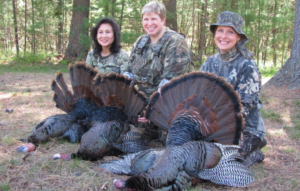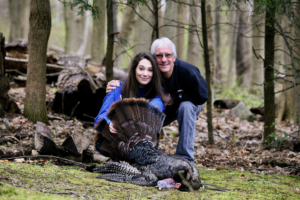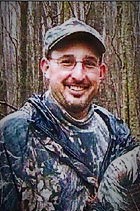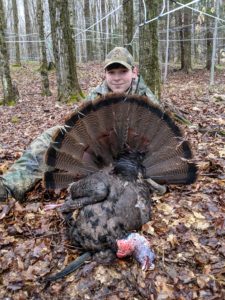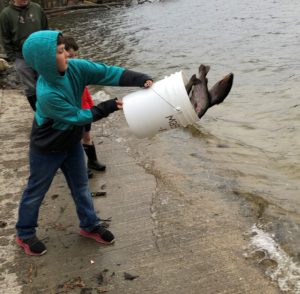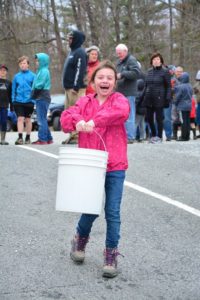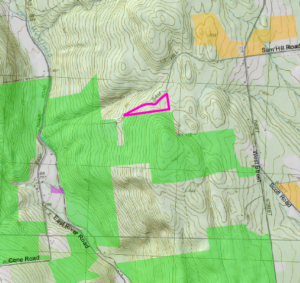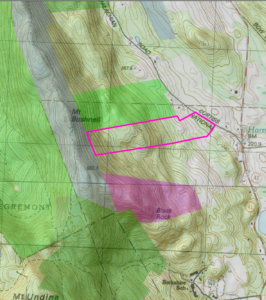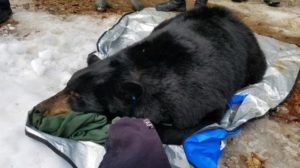Can you believe it? Fall bear hunting season is opening already. Gosh, where does the time go. The first bear hunting season runs from Sept. 3 to Sept. 21, the second season from Nov. 4 to Nov. 23 and the Shotgun season runs from Dec. 2 to Dec. 14 (concurrent with the shotgun deer hunting season). Hunting is prohibited on Sundays. 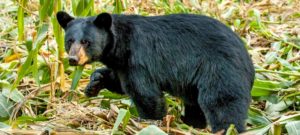
The regulations are complicated, so here we go:
The Hunting hours begin ½ hour before sunrise and end ½ hour after sunset. (Except on WMAs stocked with pheasant or quail during the pheasant or quail season, hunting hours are sunrise to sunset.)
To hunt black bear in Massachusetts you must have the appropriate license and permit, which you can buy through MassFishHunt. Licenses required for Massachusetts residents are a hunting or sporting license and a bear permit. Non-residents need a big game license and a bear permit.
Bear hunters are allowed to take one bear per calendar year.
Hunting implements
Hunting implement First season Second season Shotgun season
Rifle* X X
Handgun* X
Muzzleloader* X X X
Archery X X X
Shotgun X
*Except on WMAs stocked with pheasant or quail during the pheasant or quail season.
The rifle caliber must be a.23 or larger. Handgun: .357 Magnum revolver with .357 Magnum cartridges only, or a revolver .40 caliber or larger. Muzzleloader: .44 to .775 caliber, fired from the shoulder, using a single projectile.
Archery Equipment: Bows must have a draw weight of at least 40lbs at 28 inches or at peak draw. Arrows must have a well sharpened steel broadhead blade not less than 7/8 inches in width. Expanding broadheads are legal. Poisoned arrows, explosive tips and bows drawn by mechanical means are prohibited. Crossbows may be used by certain permanently disabled persons by permit only.
Shotgun: Allowed only during the shotgun season, shotgun not larger than 10 gauge, including shotguns with a rifled bore, slugs only.
Hunter orange requirements
• First Season: None
• Second Season: A hunter orange hat is required on WMAs stocked with pheasant or quail during the pheasant or quail season.
• Shotgun Season: You must wear 500 square inches of hunter orange on your head, chest, and back.
It is illegal to use bait and dogs.
Special rules on Wildlife Management Areas (WMAs) stocked with pheasant or quail during the pheasant or quail season
• Hunting hours are sunrise to sunset
• Hunter orange hat is required
• Other rules apply – check the WMA regulations
Upon killing a bear, hunters must immediately fill out and attach to the carcass the “harvest tag” found on the bear permit. The bear must remain intact (other than field dressing), with the harvest tag attached, until it is reported and prepared for food or taxidermy.
Hunters must report their bear either online or at a check station within 48 hours of harvest. If reporting online, a confirmation number will be issued and must be written on the harvest tag, if reporting at a check station a metal seal will be attached to the carcass. Either the seal or the harvest tag must be attached to the bear until it is processed. When transporting the bear, some portion of the carcass must remain visible until it has been reported.
The statewide population of bears is estimated to be over 4,500 animals and is growing, so the hunters’ odds are pretty good at getting one.
Gray squirrel hunting season
Thursday, September 9 marks the opening of the Gray Squirrel hunting season in Zones 1 through 9. (Yes, there are quite a few local squirrel hunters who relish a good squirrel and dumplings meal). Rather than confuse the hunters with another set of hunting regulations, I refer you to the MassWildlife web page https://www.mass.gov/service-details/gray-squirrel-hunting-regulations. There you will find squirrel hunting regulations such as Hunting Hours, Required License, bag limits, type of hunting implements, hunter orange requirement, and more.
Non-resident hunters, take note
There are non-resident readers of this column from NY and elsewhere who are interested in hunting in Massachusetts but are a little confused about our hunting regulations. The following information comes from the 2019 Freshwater Fishing, Hunting and Trapping Laws. Non-Resident Hunters:
• Must have a valid Massachusetts non-resident hunting license in order to hunt.
• Must have successfully completed a Basic Hunter Education course or held a hunting license anywhere in North America prior to 2007 in order to purchase a Massachusetts hunting license. Non-resident adults and minors (ages 15–17) purchase the same class license, H5 or H6 (see below for explanations).
H5 – Non-resident (adult/minor) Hunting, Big Game (Deer, Bear, Turkey, and all other game species) $99.50.
H6 – Non-resident (adult/minor) Hunting, Small Game (All game species except deer, bear, and turkey) $65.50.
• Must obtain the same stamps and permits as residents which are the same for residents and non-residents. Non-resident migratory game bird hunters must complete a Massachusetts H.I.P. survey to hunt.
• May not purchase ammunition in Massachusetts (including materials used in black powder firearms).
• Must have their firearms unloaded and enclosed in a case while travelling into or through Massachusetts.
• No gun license (FID) is needed to possess or transport long guns.
• Should contact the Massachusetts Criminal History Systems Board (CHSB) Firearms Support Services, 200 Arlington St., Suite 2200, Chelsea, MA 02150, tel. (617) 660-4780 for information on handgun permits.
Culvert Replacements
The Baker-Polito Administration recently awarded $932,000 to support 16 statewide culvert replacement projects that improve municipal infrastructure, river health and resilience to climate change.
Grants of interest to local environmentalists and outdoor sportspersons are as follows:
Chester (Trout Unlimited), $30,000 – Trout Unlimited, the Town of Chester and other project partners will use the grant funds to construct a structure that meets improved stream crossing and engineering design standards. Replacing this undersized and failing culvert on Kinne Brook Road with larger, safer structures will allow full upstream and downstream movement of aquatic species, including native eastern brook trout, and reduce the risk of road damage and failure in flood conditions.
Clarksburg, $41,000 – The Town of Clarksburg will conduct field data collection and analysis, design and engineering, and permitting for a culvert replacement on Bear Swamp Brook. Upgrading the culvert allows coldwater species to access to critical coldwater streams, particularly important as the climate warms and stream temperature increases. The road also serves a primary emergency access route.
Cummington, $80,000 – The Town of Cummington will complete design and engineering tasks for the culvert replacement on the North Branch of the Swift River. Upgrading the culvert will enhance public safety, resiliency, and ecological conditions and maintain economic connectivity. The North Branch Swift River is a tributary to the Wild & Scenic Westfield River, a coldwater stream that provides critical habitat for state-listed fish only found in Massachusetts in the upper tributaries of the Westfield River.
Sheffield, $54,000 – The Town of Sheffield will conduct final engineering and design and permitting for a culvert replacement on Dry Brook. The current structure results in frequent roadway flooding and repair costs. Upgrading this culvert will improve Sheffield’s infrastructure and storm resilience, reduce maintenance costs, and improve passage for fish and wildlife, including the federally listed bog turtle.
Culverts are a critical yet hidden part of our infrastructure, yet so many are in disrepair,” said State Senator Adam Hinds (D-Pittsfield). “This funding will go a long way towards our continued work with local officials to address their needs.”
“I am grateful to Secretary Theoharides for making this announcement in Windsor and for recognizing the importance of partnership between the state and our small, rural communities,” said State Representative Paul Mark (D-Peru). “Rural towns often face tough situations and tough choices when it comes to budgeting. Every state investment we are able to help secure goes such a long way towards sustainability and the long-term health of our region. This grant will be put to good use and will help improve our environment for natural habitat and nature lovers.”

